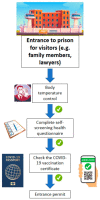The Risk of COVID-19 Infection in Prisons and Prevention Strategies: A Systematic Review and a New Strategic Protocol of Prevention
- PMID: 35206884
- PMCID: PMC8872582
- DOI: 10.3390/healthcare10020270
The Risk of COVID-19 Infection in Prisons and Prevention Strategies: A Systematic Review and a New Strategic Protocol of Prevention
Abstract
Health risks within prisons are well known and have worsened with the 2019 coronavirus pandemic (COVID-19), becoming a public health emergency. To date, there are more than 10 million inmates in the world; in most cases, conditions are bad and health care is scarce. A SARS-CoV-2 outbreak inside a prison is extremely rapid. The aim of this systematic review was to analyze all possible prevention techniques to reduce the risk of COVID-19 related infection within prisons. A systematic review of the literature was performed according to the PRISMA guidelines. Scopus, Web of Science, PubMed, and Google Scholar were used as search engines from 1 January 2020 to 1 November 2021 to evaluate the prevention of COVID-19 in prisoners. A total of 1757 articles were collected. Of them, 486 duplicates were removed. A total of 1250 articles did not meet the inclusion criteria. In conclusion, 21 articles were included in the present systematic review. From this analysis, it emerged that the most common COVID-19 prevention methods were the screening of the entire population (prisoners and workers) inside the prison through swab analysis and the reduction in overcrowding in prisons. Few studies concerned the prevention of COVID-19 infection through vaccination and the implementation of quarantine. To our knowledge, this is the first systematic review that evaluates the prevention of COVID-19 within jails and the real effectiveness of all possible methods used and published in the literature. Finally, a very useful strategic protocol is provided to reduce the incidence of infection and to control and manage COVID-19 in prisons.
Keywords: COVID-19; management strategies; prevention; prison; risk of infection.
Conflict of interest statement
The authors declare no conflict of interest.
Figures
Similar articles
-
Determining the Prevalence and Incidence of SARS-CoV-2 Infection in Prisons in England: Protocol for a Repeated Panel Survey and Enhanced Outbreak Study.JMIR Res Protoc. 2022 Jan 12;11(1):e30749. doi: 10.2196/30749. JMIR Res Protoc. 2022. PMID: 34751157 Free PMC article.
-
COVID-19 Risk Management and Screening in the Penitentiary Facilities of the Salerno Province in Southern Italy.Int J Environ Res Public Health. 2020 Oct 31;17(21):8033. doi: 10.3390/ijerph17218033. Int J Environ Res Public Health. 2020. PMID: 33142740 Free PMC article.
-
Health Management in Italian Prisons during COVID-19 Outbreak: A Focus on the Second and Third Wave.Healthcare (Basel). 2022 Jan 31;10(2):282. doi: 10.3390/healthcare10020282. Healthcare (Basel). 2022. PMID: 35206896 Free PMC article.
-
Investigation of a COVID-19 outbreak at a regional prison, Northern Uganda, September 2020.Pan Afr Med J. 2022 Sep 6;43:10. doi: 10.11604/pamj.2022.43.10.33598. eCollection 2022. Pan Afr Med J. 2022. PMID: 36284891 Free PMC article. Review.
-
Palliative and end-of-life care in prisons: a content analysis of the literature.Int J Prison Health. 2014;10(3):172-97. doi: 10.1108/IJPH-05-2013-0024. Int J Prison Health. 2014. PMID: 25764177 Review.
Cited by
-
Knowledge and Preventive Measures of COVID-19 Among Prison and Detention Center Staffs in Bench-Sheko Zone, Southwest Ethiopia.Environ Health Insights. 2023 Nov 20;17:11786302231212054. doi: 10.1177/11786302231212054. eCollection 2023. Environ Health Insights. 2023. PMID: 38021106 Free PMC article.
-
Evaluation of antibody response to SARS-CoV-2 variants after 2 doses of mRNA COVID-19 vaccine in a correctional facility.Hum Vaccin Immunother. 2022 Dec 30;18(7):2153537. doi: 10.1080/21645515.2022.2153537. Epub 2022 Dec 12. Hum Vaccin Immunother. 2022. PMID: 36503363 Free PMC article.
-
Dynamic contact networks of residents of an urban jail in the era of SARS-CoV-2.Epidemics. 2024 Jun;47:100772. doi: 10.1016/j.epidem.2024.100772. Epub 2024 May 15. Epidemics. 2024. PMID: 38776713 Free PMC article.
-
The Floating Signifier of 'Safety': Correctional Officer Perspectives on COVID-19 Restrictions, Legitimacy and Prison Order.Br J Criminol. 2022 Nov 12;63(5):1237-1254. doi: 10.1093/bjc/azac088. eCollection 2023 Sep. Br J Criminol. 2022. PMID: 37600930 Free PMC article.
-
The management of COVID-19 in prisons - the case of Northern Ireland.Health Justice. 2025 Jul 1;13(1):40. doi: 10.1186/s40352-025-00350-8. Health Justice. 2025. PMID: 40591149 Free PMC article.
References
-
- Pattavina A., Palmieri M.J. Fears of COVID-19 Contagion and the Italian Prison System Response. Vict. Offenders. 2020;15:1124–1132. doi: 10.1080/15564886.2020.1813856. - DOI
Publication types
LinkOut - more resources
Full Text Sources
Research Materials
Miscellaneous




